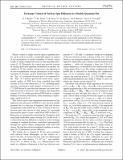| dc.contributor.author | Reilly, D. J. | |
| dc.contributor.author | Taylor, J. M. | |
| dc.contributor.author | Petta, J. R. | |
| dc.contributor.author | Marcus, Charles M. | |
| dc.contributor.author | Hanson, Micah P. | |
| dc.contributor.author | Gossard, A. C. | |
| dc.date.accessioned | 2011-08-26T15:25:14Z | |
| dc.date.available | 2011-08-26T15:25:14Z | |
| dc.date.issued | 2010-06 | |
| dc.date.submitted | 2009-01 | |
| dc.identifier.issn | 0031-9007 | |
| dc.identifier.uri | http://hdl.handle.net/1721.1/65400 | |
| dc.description.abstract | The influence of gate-controlled two-electron exchange on the relaxation of nuclear polarization in small ensembles (N∼10[superscript 6]) of nuclear spins is examined in a GaAs double quantum dot system. Waiting in the (2,0) charge configuration, which has large exchange splitting, reduces the nuclear diffusion rate compared to that of the (1,1) configuration. Matching exchange to Zeeman splitting significantly increases the nuclear diffusion rate. | en_US |
| dc.description.sponsorship | United States. Army Research Office/Intelligence Advanced Research Projects Activity | en_US |
| dc.description.sponsorship | United States. Defense Advanced Research Projects Agency | en_US |
| dc.description.sponsorship | National Science Foundation (U.S.) - Nanotechnology and Interdisciplinary Research Team (NIRT) (EIA-0210736) | en_US |
| dc.description.sponsorship | Massachusetts Institute of Technology. Pappalardo Program | en_US |
| dc.language.iso | en_US | |
| dc.publisher | American Physical Society | en_US |
| dc.relation.isversionof | http://dx.doi.org/10.1103/PhysRevLett.104.236802 | en_US |
| dc.rights | Article is made available in accordance with the publisher's policy and may be subject to US copyright law. Please refer to the publisher's site for terms of use. | en_US |
| dc.source | APS | en_US |
| dc.title | Exchange Control of Nuclear Spin Diffusion in a Double Quantum Dot | en_US |
| dc.type | Article | en_US |
| dc.identifier.citation | Reilly, D. J. et al. “Exchange Control of Nuclear Spin Diffusion in a Double Quantum Dot.” Physical Review Letters 104.23 (2010) © 2010 The American Physical Society | en_US |
| dc.contributor.department | Massachusetts Institute of Technology. Department of Physics | en_US |
| dc.contributor.approver | Taylor, J. M. | |
| dc.contributor.mitauthor | Taylor, J. M. | |
| dc.relation.journal | Physical Review Letters | en_US |
| dc.eprint.version | Final published version | en_US |
| dc.type.uri | http://purl.org/eprint/type/JournalArticle | en_US |
| eprint.status | http://purl.org/eprint/status/PeerReviewed | en_US |
| dspace.orderedauthors | Reilly, D. J.; Taylor, J. M.; Petta, J. R.; Marcus, C. M.; Hanson, M. P.; Gossard, A. C. | en |
| mit.license | PUBLISHER_POLICY | en_US |
| mit.metadata.status | Complete | |
